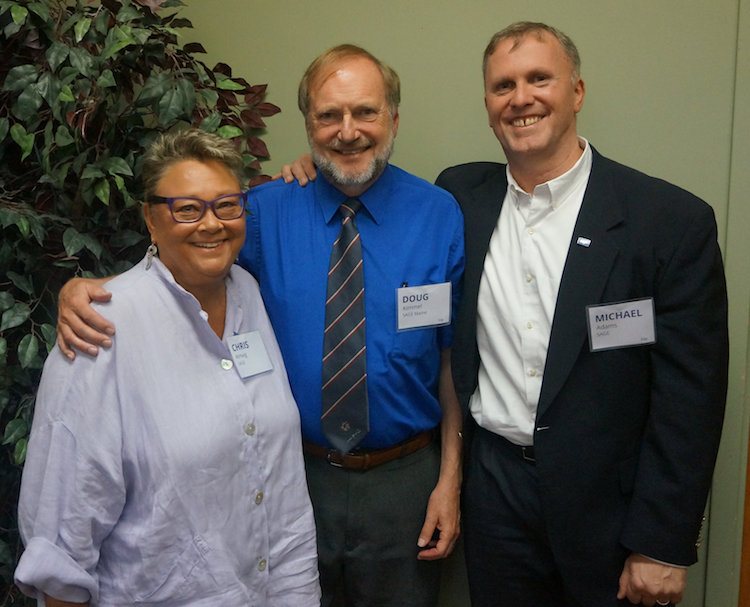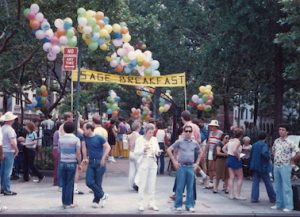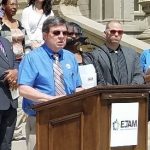SAGE in the Beginning
What better way to celebrate 40 Fierce Years of SAGE than to hear from SAGE’s fierce founders Doug Kimmel and Chris Almvig? Here are some highlights from an interview with SAGE CEO Michael Adams.
 CHRIS ALMVIG received NOW’s Susan B. Anthony Award for founding SAGE. Her research “The Invisible Minority: Aging & Lesbianism” (1982), was among the first on the lives of older lesbians.
CHRIS ALMVIG received NOW’s Susan B. Anthony Award for founding SAGE. Her research “The Invisible Minority: Aging & Lesbianism” (1982), was among the first on the lives of older lesbians.
DOUG KIMMEL is a SAGE founder and retired professor at City College, CUNY (1970-1998). A member of the Maine Psychological Association, he founded SAGE Maine.
MICHAEL ADAMS is Chief Executive Officer of SAGE and has led the organization for 12 years.
Michael Adams: For those who don’t know about your history, what was your background before starting SAGE?
Doug Kimmel: When I was in graduate school back in the 1960s, homosexuality was a medical condition that was considered a mental illness. I was studying Human Development and I was wondering whether I would be able to become a licensed psychologist. By 1973, the American Psychiatric Association was persuaded to remove homosexuality from its list of mental disorders and so I attended the first meeting of the Association of Gay Psychologists. At that time, aging was something that wasn’t very popular in the gay community, but I was studying and teaching aging. I decided that it was natural to start doing research on gay men and aging.
Chris Almvig: I’ve had a lifelong interest in older people. I never wanted to babysit; I grandma-sat back in the 1950s. There weren’t any assisted living or retirement communities—elders lived at home and so if they wanted to play cards or do something, they would call on me. I spent hours playing gin rummy or canasta. In my adult life, I converted that passion into action. I dedicated my studies and my career to gerontological services administration.

Michael: What were some of the biggest challenges and opportunities in founding SAGE?
Doug: Well, let me take you back to 1977. In those days not many of us could be open about being gay, but because I had tenure, I could be. Chris called and invited me to have coffee and we started talking about this project of hers about providing services for older LGBTQ+ people. Then, we organized a meeting at the home of one of the people that she had been talking with who also provided some financial support to get us started. We came up with the name SAGE at the second meeting. We liked the sound of it but recognized that this name had been incorporated already by a publishing company. So, we had to come up with an acronym that fit. It was 22-year-old Lee Sullivan who, sitting cross-legged on the floor, came up with the idea “Senior Action in a Gay Environment.” It lasted for decades. We began developing protocols for friendly visiting and for reaching out to these lonely, isolated, older people. We developed trainings for friendly visitors and we got all this in place. But we didn’t have any clients. Nobody came. So we invited the New York Times to write an article about us. A man named Ron Alexander did a fine article but the Times wouldn’t publish it because, in those days, they wouldn’t publish anything that was positive about gay men. And then Chris organized a social—a dance—and that’s what got the word out. People came and danced and began talking about SAGE. Eventually we wound up having a spot on the Phil Donahue Show.
Chris: Dreams seem to start sometimes unconsciously and sometimes through the relationships you have with other people. One of my first relationships was with someone who would’ve wanted to have a sex change if she could have, but at the time they weren’t very available. I started to see the struggles that she had—some of the same struggles we’re having today—about bathrooms. She couldn’t go into the men’s bathroom and she couldn’t go into the women’s bathroom and I witnessed that she could only leave home for short periods of time because she had to come back in order to use the bathroom. She had a dishonorable discharge from the army. There was a witch-hunt and somebody turned her in. She had problems with employment all through her life just because of the way she looked. So sometimes people have this big impact on you to start understanding the kind of discrimination that people experience. This combined with my early experience with LGBTQ+ elders—the amount of depression, alcoholism and isolation I saw—my dream was to be part of creating housing for the elderly. Eventually that dream turned into coffee with Doug and blossomed into SAGE.
Michael: So many themes are still present today, like outreach, choosing leadership, invisibility, discrimination, trans issues, substance abuse, isolation, desperation. Looking ahead, our new strategic plan has a big emphasis on increasing our impact on the lives of LGBTQ+ elders. As you think back, that notion of big impact—in what ways is that reflective of the spirit of SAGE?
Doug: One of the issues that was always there was gender parity. I think one of the brilliant things we did was to recognize the importance of having male and female co-chairs of the board. We also had a vision that somehow we needed to move slowly and establish a firm foundation—to be an organization that no one could assail—because of the many stereotypes and prejudices about old gay and lesbian people. If you read some of the documents at that time we were described in some of the most pernicious ways, so we had to be above reproach in order to change those attitudes. That was our biggest challenge.
Michael: One part of our strategic plan is what we call “taking care of our own”—a continued commitment to the most vulnerable elders in our communities. To what degree was that the orientation in the early days?
Doug: Indeed I think we were focused on taking care of our own from the very beginning. There was a gay male couple who were among the very first people we visited. It turned out that Bruhs Mero had been a former dancer and singer and his partner was a pianist and so they came and played for the socials. They wound up transforming their lives into a very famous gay couple—on the cover of some magazines, on TV and ultimately a book called The Oldest Gay Couple in America by Gean Harwood. The remarkable thing about the socials was that they were all intergenerational. My husband and I really enjoyed the brunches because we were young people at the time, and we would dine with these couples who had been together 30 or 40 years and we learned how to do it. We learned that it was possible. It was really so important to have those mentors. That was the thing that we got out of SAGE. More than what we gave in many ways—the mentorship.
Chris: In terms of learning the needs of our LGBTQ+ elders, I like to use the example of our very first client, Audrey. I was her case manager and I knew there were neighbors who were shopping for her so I wondered why we needed to continue our services if she had someone to shop for her? But then I saw that there was something else that she needed. She needed someone to talk to. You see, when her neighbors came over to help her shop, she turned the portrait of her lifelong partner who had passed away face down on the piano so that they couldn’t see it. When we came to visit she was able to talk with us about her. This was of monumental importance to the heart of the work that we were learning how to do—to cater to the needs of our LGBTQ+ elders that we were only just recognizing.
Michael: We are living in a time when more than 50% of people living with HIV are 50 and older. AIDS played a tremendous role in our history. What impact did AIDS have on the organization and are there any lessons we can derive from that?
Doug: Our first president was Emery Hetrick—you’d recognize his name from the Hetrick-Martin Institute. His partner was Damien Martin and they both died of AIDS. We signed the incorporation documents in their apartment in 1978. One of SAGE’s executive directors, Ken Dawson, died in 1992 at the age of 45 from AIDS. AIDS certainly had a major impact across the board.
Chris: Richard Gold was one of the first organizers. Richard was a colorful character and was very interested in SAGE’s work. Suddenly, he stopped coming to Board meetings and we couldn’t reach him. So I went over to his apartment and his mom answered the door and wouldn’t let me come in. The next week we heard he died. This was at the same time that Time Magazine had the cover “The Gay Plague.” He was the first one, and it was all very mysterious to us at the time. Going to his funeral—it just took our breath away, and there was this snowball effect. There was never a time that you weren’t grieving. It was constant. It would go on and on and you’d be mourning three people at once. You never get over it. Through it all, we went on. I can’t even talk any more about what happened during that time because it was too much. It was just too much.
Doug: If there’s a silver lining in the AIDS epidemic, it was that a lot of people came out who would not otherwise have come out and we know from research that knowing someone who is gay is the most effective way of reducing the prejudices against gay people.
Michael: As we celebrate SAGE’s 40 years, are there any other words you want to share?
Chris: I’m aware that many cities that seek SAGE affiliation do so with support groups in mind, but it ends there. I would like to see SAGE help affiliates with the natural evolution of support groups to direct services. We always said that “community means taking care of our most vulnerable.” I see SAGE taking that to a larger level with their federal advocacy efforts, but I would love to see the affiliate networks expand even more.
Doug: I would say that the changes since the AIDS crisis have been amazing: marriage, LGBTQ+-friendly housing for seniors, SAGE senior centers around New York City, and SAGE affiliates across the country—to name only the most obvious ones! Now SAGE is moving into the forefront of aging advocacy organizations, bringing our 40 years of experience to the political discussions of this new era in the struggle for the rights and dignity of all persons. I’m very excited for the future.







